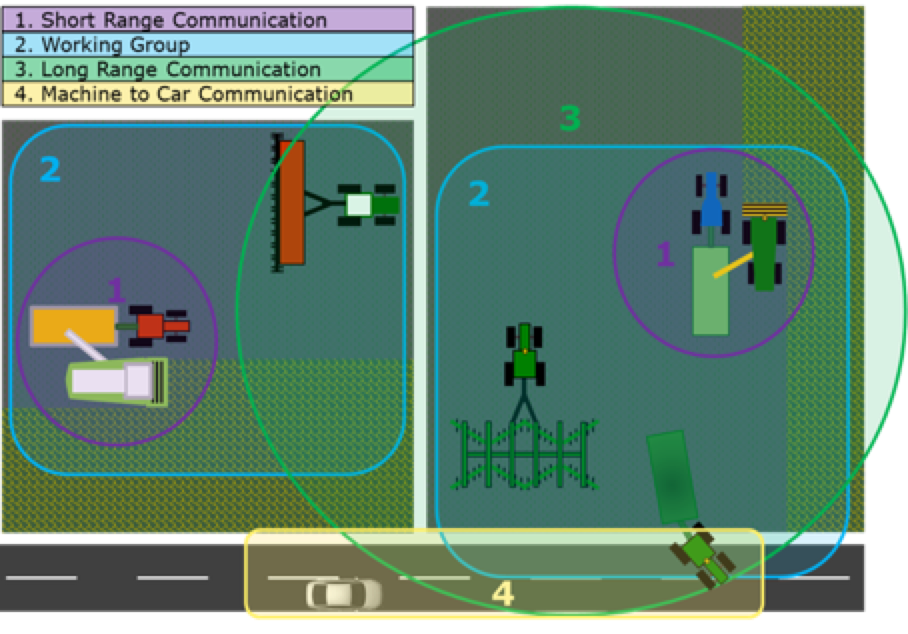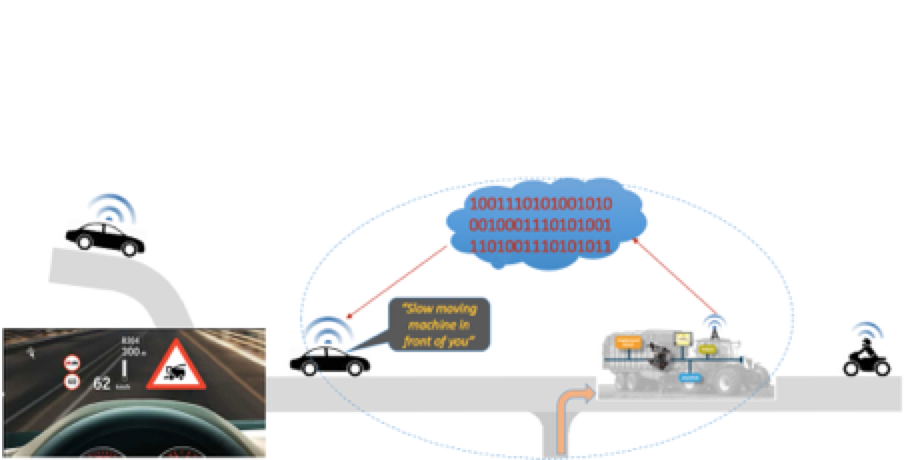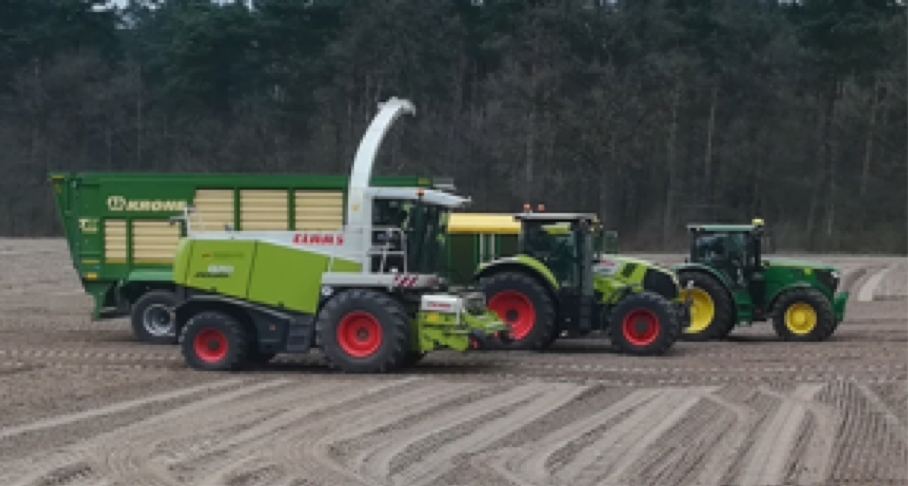Activity Report
AEF – Wireless In-Field Communication
The agricultural industry is supplying a diverse market and is driven by innovations of numerous manufacturers. The objective of the Agricultural Industry Electronics Foundation (AEF) [1] is the interoperability of different manufacturer’s equipment via common standards. This is being facilitated by joint approaches of the industry to technical challenges around electrical systems, electronics and software in agricultural technology and farming.
The AEF was initially established to create guidelines for the standardization of ISO 11783 (commonly known as ISOBUS [2]) systems, this focus has been expanded to a wider range of topics to include electrification, camera systems, farm management information systems (FMIS), Ethernet communication and wireless in-field communication (WIC).
AEF Project Team 11 was tasked with taking a detailed look into wireless in-field communication. Their focus has taken into account technology decisions for suitable radio standards, corresponding transport layer protocols for machine-to-machine (M2M) communication and secure communication methods. M2M standards enable direct communication between cooperating machines.
Market Drivers & Visions
The diversity of the agricultural equipment market leads customers to operate fleets from various manufacturers. As a matter of the digital evolution in the agricultural industry, connectivity and data exchange between cooperating machines is essential. This includes local information flow like machine synchronization, guidance lines and coverage sharing as well as end-to-end communication. For the machines in the field, this data exchange provides assistance and leads into fully automated workflows. In the future, global connectivity will be the basis for remote implementations of agronomic decisions as well as autonomous field operations.
Objectives
Standardized M2M communication between equipment of different manufacturers in the agricultural domain creates high value opportunities for customers worldwide and is the basis of the goals for this project team.
- Use case definition for Ag Machinery
- Definition of radio standard for short- and mid-range wireless communication
- Usage and integration of existing communication protocols
- Specification of common software library
- Functional safety and security concept
- Conformance testing
- Application guideline including usage examples
The project team defines a framework for secure M2M communication. For the physical communication layer, it intends to adopt existing industry standards of the telecommunication and vehicular communication domain. Specific demands in terms of reliability, safety, security and responsiveness from a wireless communication system will be required to determine sophisticated layer protocols.
AEF is considering the creation of a manufacturers-independent library to provide a common communication layer similar to the security library developed for tractor-implement-management. The system is currently under development and helps to provide the security needed.
Compliance with the communication standard as well as the safety and security guidelines will be approved by a AEF conformance testing [3]. As a final development stage, an AEF guideline is planned that can be incorporated into ISO 16867 - Tractors and machinery for agriculture and forestry - wireless communication in agriculture [4].
Key Scenario and Use Cases
The illustration below shows the key scenario for M2M communication. The scenario shows four examples of communication with their specific ranges and group definitions. Example 1 (Short-Range-Communication) defines a pair of machines working in close cooperation via exchange of real-time control data. A typical use case for this communication layer is parallel platooning between a harvester and a trailer in order to unload grains.

Example 2 covers a whole working performing cooperative work on one or more fields in a mid-range distance of up to few kilometers. This group would exchange process data such as guidance lines and coverage maps. All equipment of the same farm or contractor visible in example 3 is part of a global communication group in order to exchange logistic information with a Farm Management Information System. This example of communication requires connectivity to the outside via e.g. internet.
Example 4 combines Ag Machinery with car-to-car network standards and can provide road safety information with on-highway traffic.
Use cases in the real-time control category include assistance systems for unloading grains during a harvesting process or additional scenarios where cooperative machines join in a leader-follower setup. These scenarios are concluded under the terms virtual drawbar or longitudinal and parallel platooning. Real-time exchange of control data is essential for these applications, which requires strict latency constraints.
Streaming Services are based on the point-to-point transmission of continuous high-volume and low-latency data. This is a main characteristic of real-time video streams as they might be produced by a remote camera or a remote display system. Similarly, high-definition sensor information, which may include camera sources as well as other types of data, can be sent to a remote participant for data analysis or processing. Ideally, these use cases are possible via a mid-range radio technology (few 100 m).
Cooperative machines have an intrinsic demand to share recorded work progress data. This includes coverage data avoiding multiple operations on the same area and consolidate the distributed work state into consistent application maps. This is particularly important for pesticide applications, which are subject to strict regulations. A pre-condition for efficient cooperative work in the same field is the exchange of guidance lines and coverage maps.
The AEF is working on a solution for this exchange of relevant ISO 11783-10 data called Extended FMIS Data Interface. For the use cases of this category, the range of the radio standard is the dominant factor. Since distances within a single field might span several kilometers in some regions, a long-range physical layer technology is desirable.
Timely access to process data of the entire fleet is crucial for economic and agronomic decisions within a farming or contractor business. Farm Management Information Systems provide tools for collecting the required information and planning field work. Communication with such systems relies on the availability of connectivity, which might not be continuously present in the field environment.
As of 2017 not even a third of the world’s landmass has mobile network coverage. Therefore, connectivity is not possible in all areas and farmers can’t exchange data between machines. M2M is a first step in this data exchange and fills the gap of missing infrastructure.

Figure 2: AEF road safety pilot together with ETSI
Slow moving vehicles increase the risk of sudden traffic jams and collisions, as well as, by entering roads from fields surprising unexpected drivers. Agricultural equipment is involved in road traffic accidents around the globe. Wireless communication systems can improve road safety when used in conjunction with smart car features available on automobiles and motorcycles.
This safety feature has been successfully prototyped in a project between the European Telecommunication Standard Institute (ETSI) [5] and AEF.
Recommendation for communication standard
After extensive review, the AEF has decided to work with IEEE 802.11p [6]. The Cooperative Intelligent Transport System (C-ITS) [7] has obtained a dedicated frequency range located in the 5.9 GHz domain. C-ITS is based on IEEE 802.11p with an extended range of up to 1000 m. It is a promising option for the short- to mid-range communication.
During 2018 it was necessary to prove out some of the concepts the team had been working on with field testing. Together with the University of Paderborn, AEF defined a harvesting scenario to prove the usage of 802.11p.
A typical loading/unloading scenario to measure the wireless performance with three vehicles was set up. Figure 3 shows the scenario during an overtake manoeuver of one vehicles. During the overtake, a tractor with a trailer, drives from behind in between the sender and the receiver, two different shadowing effects were seen: the shadowing of the third tractor with a trailer in between the sender and the receiver and the additional shadowing due to the discharge chute during the overtaking manoeuver.

Figure 3: Picture of an overtaking manoeuver in the harvesting scenario
The results show that there are no major problems using the 802.11p protocol stack developed for automotive applications. The range that can be covered is clearly sufficient, especially since there are typically no major obstacles such as buildings on an open field.
However, the size of the harvesting machines and additional mechanics as the discharge chute have a huge impact on the signal. This has to be taken into account when designing communication systems for agricultural vehicles. A possible countermeasure could be the use of multiple antennas at different positions on the vehicle.
Collaboration
A strong collaboration between the AEF teams with the Car2Car Consortium [8], the European Telecommunications Standards Institute (ETSI), AgGateway [9] and the ISO organization [10] was established. This participation and consultancy of industrial and academic partners in the field of radio technology, communication and vehicular networks, security solutions and distributed software systems proved to be very successful and needs to continue.
For more information on this project team activities or interest in joining AEF our contact information is provided below:
AEF Office: office@aef-online.de
Conclusion
AEF intends to develop common guidelines for wireless communication for agricultural equipment. The underlying key scenario includes several use cases for data synchronization and remote control of cooperating machines.
This requires the consideration of cutting-edge industry standards, engineering solutions, as well as research in the field of wireless communications, machine-to-machine communication, industry automation and Internet of Things.
References
- [1] "Agricultural Equipment Electronics Foundation," [Online]. Available: www.aef-online.org
- [2] "AEF ISOBUS," [Online]. Available: www.aef-online.org/the-aef/isobus.html
- [3] "AEF Conformance Testing," [Online]. Available: www.aef-online.org/products/conformance-test.html
- [4] "ISO 16867," [Online]. Available: www.iso.org/committee/47156.html
- [5] "European Telecommunications Standards Institute," [Online]. Available: www.etsi.org
- [6] "IEEE 802.11p," [Online]. Available: http://grouper.ieee.org/groups/802/11
- [7] "Cooperative, connected and automated mobility (C-ITS)," [Online]. Available: https://ec.europa.eu/transport/themes/its/c-its_en
- [8] "Car 2 Car - Communication Consortium," [Online]. Available: www.car-2-car.org
- [9] "AgGateway coorperation,” [Online]. Available: www.aggateway.com
- [10] "ISO organisation,” [Online]. Available: www.iso.org
